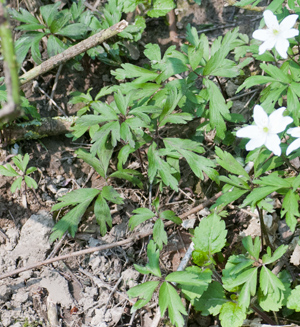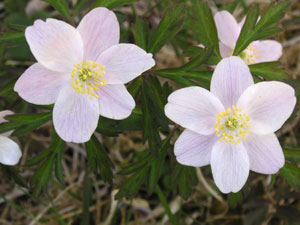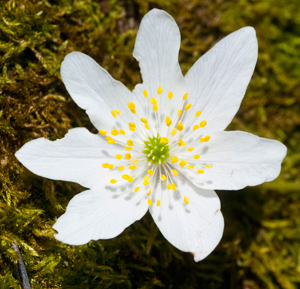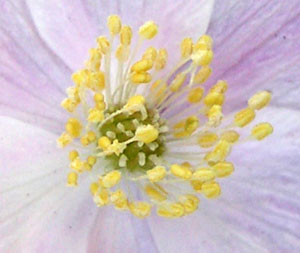Wood anemone
Leaves and stem

The leaves of the wood anemone are simple but are so deeply divided that they have the appearance of a palmate leaf - the leaf is sometimes described as trifoliate.
The leaves have a distinctive smell, often described as musky - which may account for one of the wood anemone's alternative names "smell fox".
There is a whorl of leaves just below the flower, whilst others arise from ground level on long stalks.
Flowers and Fruits

The flowers of wood anemone are white, though they can also have a pinkish tinge to them. They are between 20 and 40 mm in diameter - but usually about an inch (25 mm), and are constructed from six or more sepals (no petals).
[ Some escapes from gardens have larger flowers, with more petals ]
There are many anthers which are a golden yellow colour (see image below). The fruit when it forms is made up of many achenes (an achene is a one seeded fruit).
Ecology and other notes

The wood anemone (Anemone nemorosa) is to be found in deciduous woodlands and hedgerows. It produces solitary flowers in Spring. It is a perennial, and can spread by means of its creeping rhizome (an underground stem that 'throws up' shoots). It can spread and carpet large areas due to its vegetative spread by means of its rhizomes.
Height - about 1 ft / 30 cm. Like old man's beard, it is a member of the buttercup family - the Ranunculaceae. It is sometimes called 'windflower' because of the way the flowers shake / move in the wind.
The plant is poisonous; it contains protoanemonin, an acrid (and bitter) oil - formed from the glycoside, ranunculin. Protoanemonin can cause severe skin irritation and gastric disturbances if ingested.
